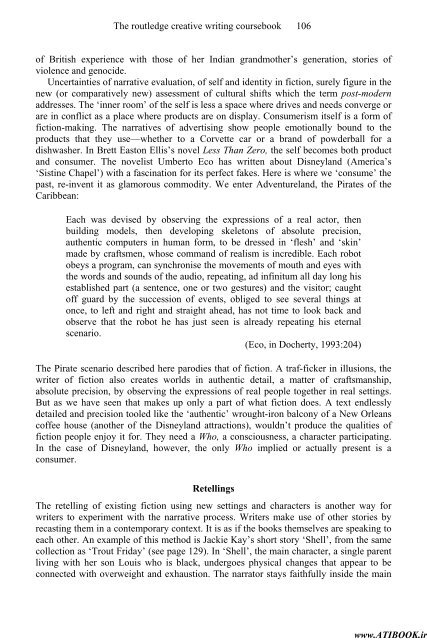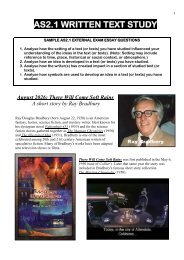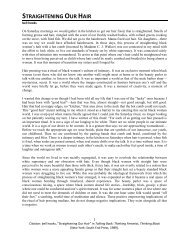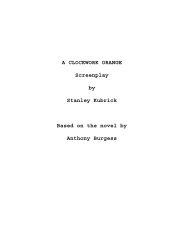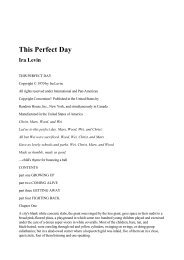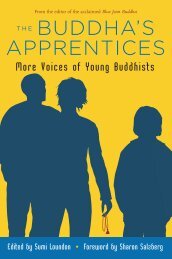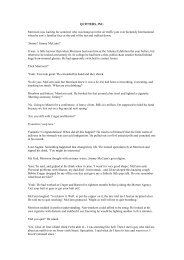9780415317856_the_routledge_creative_writing_coursebook
9780415317856_the_routledge_creative_writing_coursebook
9780415317856_the_routledge_creative_writing_coursebook
You also want an ePaper? Increase the reach of your titles
YUMPU automatically turns print PDFs into web optimized ePapers that Google loves.
www.ATIBOOK.irThe <strong>routledge</strong> <strong>creative</strong> <strong>writing</strong> <strong>coursebook</strong> 106of British experience with those of her Indian grandmo<strong>the</strong>r’s generation, stories ofviolence and genocide.Uncertainties of narrative evaluation, of self and identity in fiction, surely figure in <strong>the</strong>new (or comparatively new) assessment of cultural shifts which <strong>the</strong> term post-modernaddresses. The ‘inner room’ of <strong>the</strong> self is less a space where drives and needs converge orare in conflict as a place where products are on display. Consumerism itself is a form offiction-making. The narratives of advertising show people emotionally bound to <strong>the</strong>products that <strong>the</strong>y use—whe<strong>the</strong>r to a Corvette car or a brand of powderball for adishwasher. In Brett Easton Ellis’s novel Less Than Zero, <strong>the</strong> self becomes both productand consumer. The novelist Umberto Eco has written about Disneyland (America’s‘Sistine Chapel’) with a fascination for its perfect fakes. Here is where we ‘consume’ <strong>the</strong>past, re-invent it as glamorous commodity. We enter Adventureland, <strong>the</strong> Pirates of <strong>the</strong>Caribbean:Each was devised by observing <strong>the</strong> expressions of a real actor, <strong>the</strong>nbuilding models, <strong>the</strong>n developing skeletons of absolute precision,au<strong>the</strong>ntic computers in human form, to be dressed in ‘flesh’ and ‘skin’made by craftsmen, whose command of realism is incredible. Each robotobeys a program, can synchronise <strong>the</strong> movements of mouth and eyes with<strong>the</strong> words and sounds of <strong>the</strong> audio, repeating, ad infinitum all day long hisestablished part (a sentence, one or two gestures) and <strong>the</strong> visitor; caughtoff guard by <strong>the</strong> succession of events, obliged to see several things atonce, to left and right and straight ahead, has not time to look back andobserve that <strong>the</strong> robot he has just seen is already repeating his eternalscenario.(Eco, in Docherty, 1993:204)The Pirate scenario described here parodies that of fiction. A traf-ficker in illusions, <strong>the</strong>writer of fiction also creates worlds in au<strong>the</strong>ntic detail, a matter of craftsmanship,absolute precision, by observing <strong>the</strong> expressions of real people toge<strong>the</strong>r in real settings.But as we have seen that makes up only a part of what fiction does. A text endlesslydetailed and precision tooled like <strong>the</strong> ‘au<strong>the</strong>ntic’ wrought-iron balcony of a New Orleanscoffee house (ano<strong>the</strong>r of <strong>the</strong> Disneyland attractions), wouldn’t produce <strong>the</strong> qualities offiction people enjoy it for. They need a Who, a consciousness, a character participating.In <strong>the</strong> case of Disneyland, however, <strong>the</strong> only Who implied or actually present is aconsumer.RetellingsThe retelling of existing fiction using new settings and characters is ano<strong>the</strong>r way forwriters to experiment with <strong>the</strong> narrative process. Writers make use of o<strong>the</strong>r stories byrecasting <strong>the</strong>m in a contemporary context. It is as if <strong>the</strong> books <strong>the</strong>mselves are speaking toeach o<strong>the</strong>r. An example of this method is Jackie Kay’s short story ‘Shell’, from <strong>the</strong> samecollection as ‘Trout Friday’ (see page 129). In ‘Shell’, <strong>the</strong> main character, a single parentliving with her son Louis who is black, undergoes physical changes that appear to beconnected with overweight and exhaustion. The narrator stays faithfully inside <strong>the</strong> main


